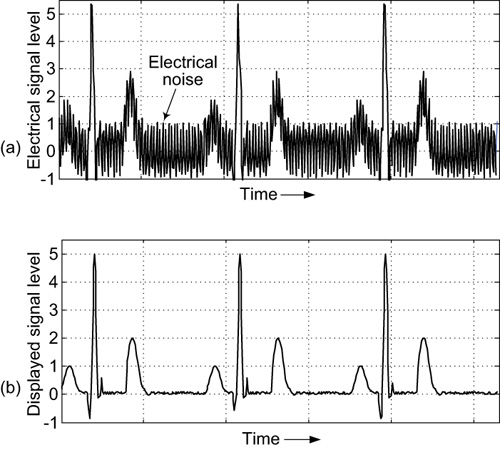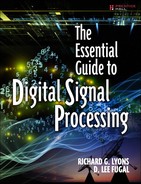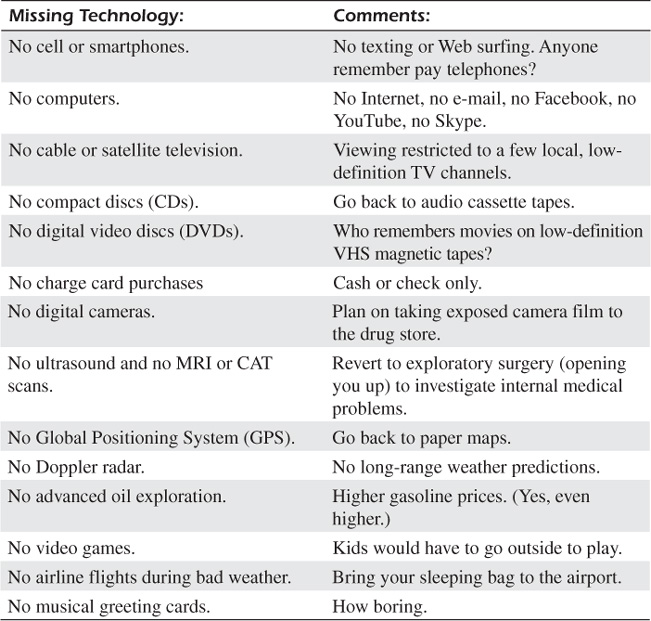1. What Is Digital Signal Processing?
The Phantom Technology
The technology of digital signal processing (DSP) has affected our modern lives in the most significant ways. If you watch television, connect to the Internet, use a digital camera, make a cell phone call, drive a car, type on the keyboard of a home computer, or use a charge or debit card, you are taking advantage of DSP. In fact, DSP is the technical brains in all those devices. Although we take advantage of DSP dozens of times a day, very few people have ever heard of digital signal processing and this strange situation is why DSP has been called a phantom technology. To show how much we depend on this invisible DSP technology, Table 1.1 provides a short list of what life would be like without DSP.
Given that we now realize how important DSP is in our daily lives, it’s reasonable to ask just what is this thing called DSP technology. To understand the meaning of the phrase digital signal processing, we must first explain what we mean by the word signal.
What Is a Signal?
Any complete definition of the word signal must be, by necessity, somewhat vague. For example, some people define a signal as any representation of information conveyed to a receiver. Rather than discussing the meanings of those defining words, let’s clarify what the word signal means to us by considering examples of signals that we’ve experienced in our daily lives. For example, when we listen to music produced by a loudspeaker, we’re experiencing a signal in the form of sound waves traveling through the air that stimulates our eardrums. When we drive our cars to a traffic intersection, a light signal radiated by a red or green traffic light tells us whether we should stop or proceed. And if we ignore the red light, we find another red light following us down the road with a siren to signal us to pull over!
When you want to make a cell phone call, the symbol on your phone’s screen, shown in Figure 1-1, is a visual indicator that your phone is receiving a sufficiently strong radio signal from a local cell phone tower. The height of a thermometer’s mercury column is a visual signal indicating temperature. When we receive a kiss on the cheek, that’s a tactile signal of affection. All of these examples are instances of receiving a signal that conveys information.
Analog and Digital Signals?
As it turns out, all signals fall into one of two major categories, analog signals and digital signals. The signals that we experience in our daily lives, the examples of sound and light signals mentioned in the previous section, are analog signals. Chapters 2 and 3 discuss analog signals in more detail.
Strangely enough, digital signals are nothing more than sequences of numbers. It’s true—sequences of numbers that can be stored in the electronic memories of computers, digital cameras, and video game machines, or recorded on CDs and DVDs. Signal processing engineers have developed a way to convert analog signals, such as a sound or light signal, into digital signals (sequences of numbers). The digital signals contain all the information of the original analog signals. In addition, signal processing engineers have also developed the means to convert a digital signal back into an analog signal (sound or light). Converting an analog signal to a digital signal and then converting the digital signal back into an analog signal doesn’t seem too useful, but that’s where digital signal processing comes in.
Digital Signal Processing
Digital signal processing is the mathematical manipulation of the numerical values of a digital signal that changes the digital signal in some advantageous way. For example, let’s say a vocalist is singing into a microphone and we convert that analog voice signal to a digital signal. Next, the values of the numbers in the digital signal can be modified such that when the modified digital signal is converted back to an analog signal and played through a loudspeaker, we hear a slight echo in the singing that gives us a more pleasant sound. Manipulating pop singers’ voices is standard operating procedure in today’s music business. We discuss that topic in more detail in Chapter 4.
For a more serious example of digital signal processing, consider undergoing an electrocardiogram (EKG or ECG) test to check for problems with the electrical activity of your heart. Small electrodes, taped to your chest, detect an analog electrical signal produced by your heart that often looks like that shown in Figure 1-2(a). For various practical reasons, the analog electrode signal is contaminated with abrupt, unwanted signal-level fluctuations, called noise, making it impossible for a doctor to evaluate your heart’s electrical activity.

Figure 1-2 Electrocardiogram signals: (a) original measured noisy signal; (b) improved signal display after digital signal processing.
Today, digital signal processing comes to the rescue. As shown in Figure 1-3, the analog electrical sensor signal is converted to a digital signal. Next, the numerical values in the digital signal are modified in a way that eliminates the unwanted noise portion of the signal. The result is a clean EKG display, as shown in Figure 1-2(b), enabling a doctor to quickly evaluate the health of your heart
Other applications for DSP include military, industrial, space exploration, photography, communications, scientific, seismic, weather and many more. As we showed earlier in Table 1.1, life would go on without the benefits of DSP. However, we would have to do without so very many conveniences that we currently enjoy.
OK, this concludes our super-brief introduction to analog and digital signals, and digital signal processing. In later chapters, we’ll learn more details about signals and signal processing.
What You Should Remember
The concepts you should remember from this chapter are:
• We experience signals throughout our daily lives, usually in the form of analog sound and light signals.
• There is a way to convert analog signals, such as sound or light signals, into digital signals (sequences of numbers) that are stored in an electronic device. The digital signals contain all the information of the original analog signals.
• The numbers in a digital signal can be mathematically modified to improve some important characteristic of the signal, or reduce unwanted noise that contaminates it.
• The processed (modified and improved) digital signal can be converted back into an analog signal if necessary.
• The applications of DSP are many and varied. We may not always see where this phantom technology of DSP is used, but our lives would be very different without it.



